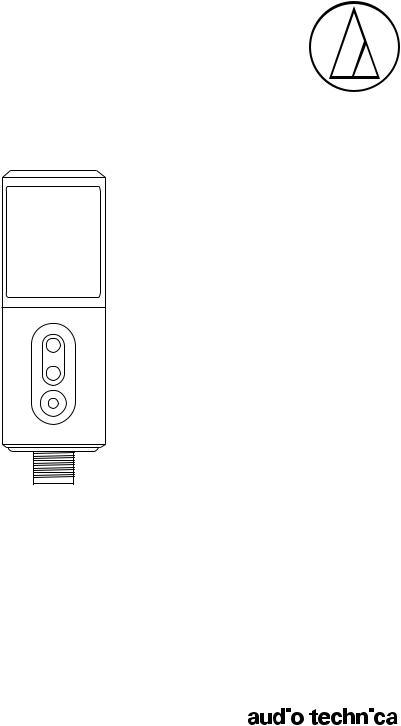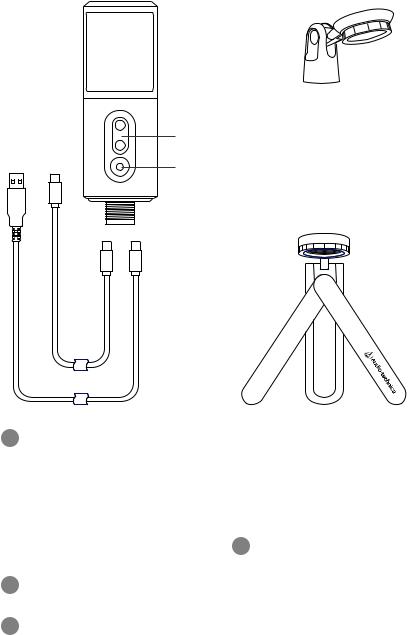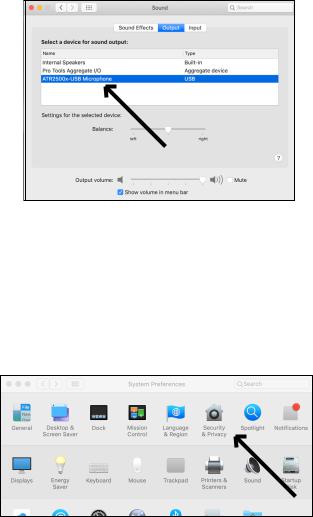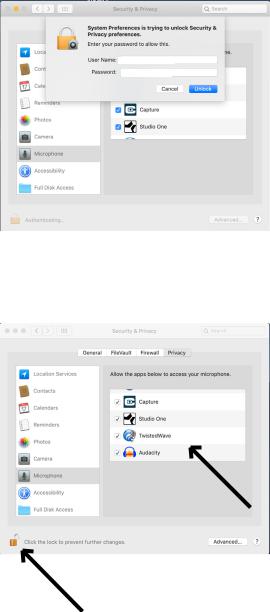Audio-technica ATR2500X-USB User Manual

ATR2500x-USB
Cardioid Condenser USB Microphone
User Manual
Contents
|
Introduction & features |
2 |
|||
Setting up your microphone with pivot mount & desk stand |
3 |
||||
Preliminary setup with MacOS Mojave |
4 |
||||
Advanced setup with MacOS Mojave |
7 |
||||
Preliminary setup with Windows 10 |
9 |
||||
Advanced setup with Windows 10 |
11 |
||||
|
Using headphones |
15 |
|||
|
Selecting software |
15 |
|||
Setting your software levels |
15 |
||||
Positioning your microphone |
15 |
||||
Protecting your microphone |
15 |
||||
|
|
|
Specifications |
16 |
|
|
|
|
Warranty |
17 |
|
|
|
|
|
|
|
|
|
|
|
|
|
|
|
|
|
|
|

Compliance with FCC rules (USA only)
This device complies with Part 15 of the FCC rules. Operation is subject to the following two conditions:
(1) this device may not cause harmful interference, and (2) this device must accept any interference received, including interference that may cause undesired operation.
FCC WARNING
You are cautioned that any changes or modifications not expressly approved in this manual could void your authority to operate this equipment.
Canada only
This Class B digital apparatus complies with Canadian ICES-003.
Cet appareil numérique de la classe B est conforme á la norme NMB -003 du Canada.
Thank you for buying the Audio-Technica ATR2500x-USB cardioid condenser microphone. Designed for computerbased recording, this microphone is ideal for digitally capturing music or any acoustic audio source using your favorite recording software.
Equipped with a USB output for easy connection to your computer, the ATR2500x-USB offers studio-quality articulation and intelligibility perfect for home studio recording, field recording, podcasting, and voice over use.
The ATR2500x-USB also features a built-in headphone jack with volume control that allows you to directly monitor your microphone’s output during recording. The microphone’s focused pickup pattern delivers excellent off-
axis rejection, while its A/D converter with up to 24-bit, 192 kHz sampling rate ensures clear, articulate sound reproduction.
Audio-Technica’s state-of-the-art design and manufacturing techniques ensure that the microphone complies with the company’s renowned consistency and reliability standards.
Features
•Side-address condenser microphone with USB output for easy connection to your computer
•Ideal for podcasting, home studio recording, field recording, and voice over use
•Built-in headphone jack lets you monitor directly from the microphone
•Controls on the front of the microphone allow you to easily adjust headphone volume
•High-quality A/D converter with up to 24-bit, 192 KHz sampling rate
•Compatible with Windows and Mac
•Low-mass diaphragm provides excellent frequency response
•Cardioid polar pattern reduces pickup of unwanted sounds from the sides and rear, improving isolation of desired sound source
•Low self-noise – ideally suited for digital recording
•Sturdy tripod desk stand with folding legs is easy to set up and transport
•Pivoting, threaded stand mount attaches securely to a conventional microphone stand
•Durable metal construction for long-lasting performance
•Includes two 2 m (6.6') cables: USB-C to USB-C, USB-C to USB-A
2

ATR2500x-USB Setup
Stand clamp
Headphone volume
USB-A USB-C
3.5 mm (⅛") headphone jack
Tripod desk stand
1For desktop use
Screw the microphone into the threaded portion of the tripod desk stand. The front of the microphone should face the A-T logo. Extend the tripod legs to provide a wide, secure base, and place the tripod desk stand on a flat surface.
For mic stand use
Screw the microphone stand clamp to your mic stand. Screw microphone into the stand clamp.
2Use a screwdriver or coin to loosen/tighten the stand’s pivot screws for angle adjustment.
3Plug one of the provided USB cables into the USB output at the base of the microphone then connect the other end of the cable to your digital recording device.
When connecting the microphone to a USB-C port, you must use a USB On-The-Go (USB OTG) cable like the one included.
When using with equipment that includes a built-in mic, consult that device’s user guide for instructions on disabling its mic.
4Optional headphone monitoring: Connect headphones with 3.5 mm (⅛") plug into front of microphone. Use up/down buttons for volume control.
3

Preliminary setup with MacOS Mojave
NOTICE Regarding MacOS Catalina
With the release of MacOS Catalina, Apple has introduced restrictions on using non-Apple software. Unless the recording application is officially supported to run under MacOS Catalina, you will not be able to access the microphone even if it shows up as a sound input device!
If you are using an older version of MacOS, your computer will automatically recognize the USB device and install the appropriate driver.
If you are using MacOS Mojave, you must enable software access to the microphone, using the security and privacy settings.
1.Connect the ATR2500x-USB microphone to an open USB port on the Mac (Type A or Type C).
Open the system preferences by clicking the Apple logo in the upper left corner of the menu bar and selecting System Preferences. Alternatively, you can click on the gear icon in the dock. Click the Loudspeaker icon to open the sound preferences.
Click the Apple Logo and select System Preferences |
Click the Loudspeaker icon to open the |
|
sound preferences |
2.By default the Mac selects the internal microphone as the sound input device. When the ATR2500x-USB is plugged in, the Mac assumes that it is the desired input device and automatically selects it.
Verify that the ATR2500x-USB is highlighted.
The input volume for the microphone can be adjusted by moving the input slider and watching the level meter while speaking into the microphone. Setting the level too low will not provide enough input signal to your recording application. Setting it too high can overload the input to the recording application resulting in clipping or distortion.
Note: The output volume slider controls the Mac’s speaker or headphone jack output and does not affect the input sound level. This slider replicates the volume control associated with the small speaker icon in the menu bar and the volume controls on the keyboard.
4

Preliminary setup with MacOS Mojave (continued)
3.Because the ATR2500x-USB Microphone has a built-in headphone output, the Mac selects it as the output device. Should you desire to use the internal speakers for playback audio, click the Output tab and choose the desired output device.
The balance control sets the left to right balance in the output device.
The Output volume controls the playback level from the Mac. It is the same as clicking on the small speaker icon in the menu bar and adjusting volume or using the keyboard controls.
With recent updates to MacOS Mojave and the latest MacOS Catalina, Apple implemented a privacy setting allowing you to control which apps have access to the microphone.
If you are using MacOS Mojave, you must enable software access to the microphone, using the security and privacy settings.
1.In order to use the ATR2500x-USB microphone with certain applications you need to verify that the apps are enabled to have access to the microphone.
Open the system preferences and click on the Security and Privacy icon.
5

Preliminary setup with MacOS Mojave (continued)
2.To make changes, you will need to unlock the padlock on the Security and Privacy window by entering your user name and password.
Scroll down to make certain the apps you want to use the microphone with are enabled. If not, use the switch slider associated with the App to turn it on.
3.Click the microphone icon and verify that a check mark appears next to the applications that need access to the microphone.
Make certain to click the lock to lock it after making the changes.
6
